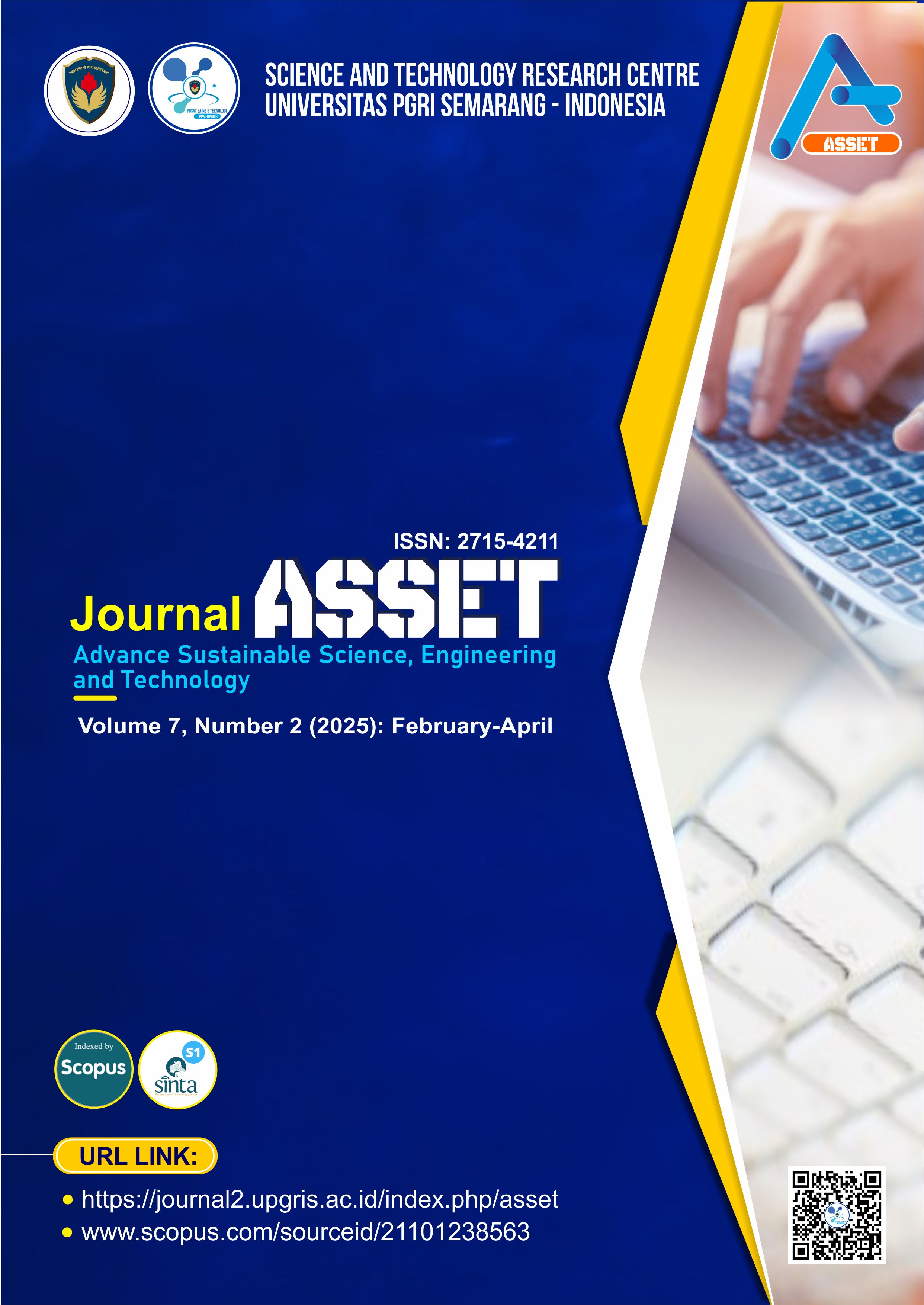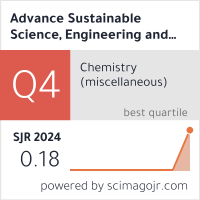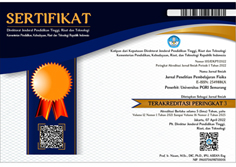Enhancing Functional Foods with Plant Extracts: A Study on Gummy Candies Containing Sungkai Leaf Extract
DOI:
https://doi.org/10.26877/tjdgyw23Keywords:
Antioxidant, bioactive compound, functional food, gummy candy, low calorie, microencapsulation, sungkai leafAbstract
Gummy candy is a popular food product, but it is generally high in calories and low in functional content. Sungkai leaves (Peronema canescens Jack) are known to contain antioxidant compounds that have the potential to be developed as functional food ingredients. To overcome the high calorie content of gummy candy, this study developed a low-calorie gummy candy formulation with the addition of encapsulated sungkai leaf extract and a low-calorie sweetener. This study aims to determine the optimal concentration of encapsulated sungkai leaf extract that produces gummy candy with optimal physicochemical, texture, antioxidant activity, and organoleptic characteristics. The study used an experimental method with Randomized Group Design (RAK), consisting of seven treatments of sweetener combination (xylitol and sucralose) and microcapsule concentration (3-7%). The results showed that the best formulation was a combination of 75% xylitol and 3% sungkai leaf extract microcapsules. This formulation produced good antioxidant activity (total phenolics 1,843 mg GAE/g; IC₅₀ of 597.878 mg/L), favorable texture (hardness 26.12 N; chewiness 42.99 Nmm), and good consumer acceptability (overall acceptability 3.71 out of 5). In addition, the caloric value was only 2.76 kcal/g, lower than conventional candy. The implications of the results of this study indicate a great opportunity for diversification of healthy food products based on local plants, as well as encouraging the development of functional food innovations that support a healthy lifestyle and prevention of degenerative diseases through the daily diet.
References
Almayda, N., Roosdiana, A., Masruri, M., & Safitri, A. (2024). Evaluation of Bioactive Compounds, Release Profiles, and Toxicity Test from Microcapsules Containing R. tuberosa L. Extracts Utilizing Gum Arabic. J. Pure App. Chem. Res, 13(1), 52–62. https://doi.org/10.21776/ub.jpacr.2024.013.01.3336
AOAC. (2005). Official Methods of Analysis of the Association of Official Agricultural Chemists International. Journal of the Association of Official Agricultural Chemists International, 41(12).
Bouphun, T., Sassa-deepaeng, T., & Krueaboon, R. (2023). Effect of Sucrose Replacer on Physicochemical Properties and Sensory Analysis of Rose Tea Gummy Jelly. International Food Research Journal, 30(2), 426–438. https://doi.org/10.47836/ifrj.30.2.13
Budiati, A., Aulena, D. N., Khirana, R. D. A. C., & Fitriyani, D. (2024). The Effectiveness of Sunscreen Cream with Ethanol Extract of Sungkai Leaves (Peronema canescens Jack). Journal of Natural Product for Degenerative Diseases, 2(1), 39–47. https://doi.org/10.58511/jnpdd.v2i1.7456
Charoen, R., Savedboworn, W., Phuditcharnchnakun, S., & Khuntaweetap, T. (2015). Development of Antioxidant Gummy Jelly Candy Supplemented with Psidium guajava Leaf Extract. KMUTNB - International Journal of Applied Science and Technology, 8(2), 145–151. https://doi.org/10.14416/j.ijast.2015.02.002
Charoenphun, N. (2021). A Study of Optimum Formula for Healthy Thai Jelly Sugar Candy Production. Walailak Journal of Science and Technology, 18(15), 1–13. https://doi.org/10.48048/wjst.2021.9655
DeGarmo, E. P., Sullivan, W. G., & Canada, J. R. (1984). Engineering Economy. Macmillan.
Dista, R., Larasati, C., Ayuningsih, S., Anggraeni, N., & Batubara, I. (2022). Formulation and Characterization of Sungkai Leaf Extract Nanoemulsion (Peronema canescens Jack). Al-Kimia, 10(2), 192–200. https://doi.org/10.24252/al-kimiav10i2.33482
Dordoni, R., Garrido, G. D., Marinoni, L., Torri, L., Piochi, M., & Spigno, G. (2019). Enrichment of Whole Wheat Cocoa Biscuits with Encapsulated Grape Skin Extract. International Journal of Food Science, 2019(1), 1–11. https://doi.org/10.1155/2019/9161840
Faisal, M., Novianti, K. P., & Ramadhan, A. M. (2023). Formulation and Evaluation of Nutraseutical Gummy Candy from Sungkai Leaves Extract (Peronema canescens Jack) with a Combination of Forest Honey (Apis dorsata) as an Antioxidant. Jurnal Sains Dan Kesehatan, 5(6), 1027–1034. https://doi.org/10.25026/jsk.v5i6.2218
Hani, N. M., Romli, S. R., & Ahmad, M. (2015). Influences of Red Pitaya Fruit Puree and Gelling Agents on the Physicochemical Properties and Quality Changes of Gummy Confections. International Journal of Food Science and Technology, 50(2), 331–339. https://doi.org/10.1111/ijfs.12638
Hartel, R. W., Von Elbe, J. H., & Hofberger, R. (2018). Confectionery Science and Technology. Springer International Publishing.
Hurler, J., Engesland, A., Poorahmary Kermany, B., & Škalko-Basnet, N. (2012). Improved texture analysis for hydrogel characterization: Gel cohesiveness, adhesiveness, and hardness. Journal of Applied Polymer Science, 125(1), 180–188. https://doi.org/10.1002/app.35414
Hutching, J. B. (1999). Food Color and Appearance (2nd Edition). Aspen Publishers, Inc.
Kanpairo, K. (2018). Effect of Different Sweeteners on the Quality of Torch Ginger (Etlingera elatior (Jack) R.M. Smith) Gummy Jelly. Burapha Science Journal, 23(2), 944–958.
Kementerian Kesehatan. (2020). Tabel Komposisi Pangan Indonesia Tahun 2020.
Kia, E. M., Ghaderzadeh, S., Langroodi, A. M., Ghasempour, Z., & Ehsani, A. (2020). Red Beet Extract Usage in Gelatin/Gellan Based Gummy Candy Formulation: Introducing Salix aegyptiaca Distillate as a Flavouring Agent. Journal of Food Science and Technology, 57(9), 3355–3362. https://doi.org/10.1007/s13197-020-04368-8
Mäkinen, K. K. (2014). Authorised EU Health Claims for Xylitol and Sugar-free Chewing Gum (SFCG). In Foods, Nutrients and Food Ingredients with Authorised EU Health Claims (Vol. 1, pp. 46–72). Elsevier Ltd. https://doi.org/10.1533/9780857098481.2.46
Naknaen, P., & Itthisoponkul, T. (2015). Characteristics of Cantaloupe Jams as Affected by Substitution of Sucrose with Xylitol. International Journal of Fruit Science, 15(4), 442–455. https://doi.org/10.1080/15538362.2015.1031433
Nishinari, K., Fang, Y., & Rosenthal, A. (2019). Human Oral Processing and Texture Profile Analysis Parameters: Bridging the Gap Between the Sensory Evaluation and the Instrumental Measurements. Journal of Texture Studies, 50(5), 369–380. https://doi.org/10.1111/jtxs.12404
Nurafifah, D. A., Widyastuti, D. A., & Minarti, I. B. (2021). Activity of Moringa oleifera seed ethanolic extract against E. coli. Advance Sustainable Science, Engineering and Technology, 3(2), 372212. https://doi.org/10.26877/asset.v3i2.9603
Nurdyansyah, F., & Widyastuti, D. A. (2020). Comparison of antioxidant activity of ethanolic, methanolic, n-hexan, and aqueous extract of Parkia speciosa peel based on half-maximal inhibitory concentration through free radical inhibition. Advance Sustainable Science, Engineering and Technology, 2(2), 343559. https://doi.org/10.26877/asset.v2i2.7129
Nurfauziyah, Yulizar, Y., & Meliana, Y. (2024). Extraction of Sungkai (Peronema cannescens Jack) leaves, Antioxidant Activity Test, and Its Nanoemulsion Formulation. E3S Web of Conferences, 503. https://doi.org/10.1051/e3sconf/202450307008
Pambayun, R., Ferdinan, M., Santoso, B., Widowati, T. W., & Dewi, S. R. P. (2018). Utilization of Betel Chewning Formulation for Processing of Functional Jelly Candy. Prosiding Seminar Nasional Lahan Suboptimal, 156–164.
Parasian, G. H. (2022). Penetapan Kadar Zinkum dari Simplisia Daun Sungkai (Peronema canescens Jack) dengan Spektrofotometri Serapan Atom [Determination of Zinc Content of Sungkai Leaf Simplisia (Peronema canescens Jack) by Atomic Absorption Spectrophotometry]. Bachelor's Thesis, Department of Pharmacy, Universitas Sumatra Utara.
Paternina, L. P. R., Moraes, L., Santos, T. D., de Morais, M. G., & Costa, J. A. V. (2022). Spirulina and Açai as Innovative Ingredients in the Development of Gummy Candies. Journal of Food Processing and Preservation, 46(12).
Pop, O. L., Kerezsi, A. D., & Ciont, C. (2022). A Comprehensive Review of Moringa oleifera Bioactive Compounds—Cytotoxicity Evaluation and Their Encapsulation. Foods, 11(23), 1–18. https://doi.org/10.3390/foods11233787
Purwayantie, S., Sediawan, W. B. S., & Raharjo, D. (2019). Production of Gallic and Glutamic Acid-Rich Extract from Albertisia Papuana Becc Leaves Using Tannase in Various pH and Temperature Hydrolysis. EurAsian Journal of BioSciences, 13, 419–424. https://www.researchgate.net/publication/344101721
Rahmawati, P. S., & Adi, A. C. (2016). Daya Terima dan Zat Gizi Permen Jeli dengan Penambahan Bubuk Daun Kelor (Moringa oleifera) [Acceptability and Nutritional Value of Jellied Candy with Moringa Leaf Powder Addition (Moringa oleifera)]. Media Gizi Indonesia, 11(1), 86–93.
Rahmi, Z. J. A., Santoni, A., Jaswandi, & Juanssilfero, A. B. (2023). GC-MS Screening of Sungkai Leaves and Relation with Its Antioxidant Capacity. IOP Conference Series: Earth and Environmental Science, 1182(1). https://doi.org/10.1088/1755-1315/1182/1/012014
Rana, M. R., Babor, M., & Sabuz, A. A. (2021). Traceability of Sweeteners in Soy Yogurt Using Linear Discriminant Analysis of Physicochemical and Sensory Parameters. Journal of Agriculture and Food Research, 5, 1–7. https://doi.org/10.1016/j.jafr.2021.100155
Rehman, S., Murtaza, M. A., & Mushtaq, Z. (2016). Xylitol as a Sweetener. In Sweeteners (pp. 1–21). https://doi.org/10.1007/978-3-319-26478-3_30-1
Rizal, D. F., Muharni, M., Yohandini, H., & Ferlinahayati, F. (2022). Standardization of Ethanolic Extract of Paronema canescens Leaves. Indonesian Journal of Fundamental and Applied Chemistry, 7(3), 136–142. https://doi.org/10.24845/ijfac.v7.i3.136
Roudbari, M., Barzegar, M., Sahari, M. A., & Gavlighi, H. A. (2024). Formulation of Functional Gummy Candies Containing Natural Antioxidants and Stevia. Heliyon, 10(11), 1–12. https://doi.org/10.1016/j.heliyon.2024.e31581
Saragih, S. N. A. (2022). Penetapan Kadar Magnesium dari Simplisia Daun Sungkai (Peronema canescens Jack) dengan Spektrofotometri Serapan Atom [Determination of Magnesium Content of Sungkai Leaf Simplisia (Peronema canescens Jack) by Atomic Absorption Spectrophotometry]. Bachelor's Thesis, Department of Pharmacy, Universitas Sumatra Utara.
Southgate, D. A. T., & Durnin, J. V. G. A. (1970). Calorie Conversion Factors. An Experimental Reassessment of The Factors Used in The Calculation of The Energy Value of Human Diets. British Journal of Nutrition, 24(2), 517–535. https://doi.org/10.1079/bjn19700050
Tarigan, I. L., Puspitasari, R. D., & Latief, M. (2023). Formulation and Characterization of a Microencapsulant of Sungkai Leaves Ethanol Extract (Peronema canescens Jack). Preprints, 1(1), 1–17. https://doi.org/10.20944/preprints202311.1821.v1
Teixeira-Lemos, E., Almeida, A. R., Vouga, B., Morais, C., Correia, I., Pereira, P., & Guiné, R. P. F. (2021). Development and characterization of healthy gummy jellies containing natural fruits. Open Agriculture, 6(1), 466–478. https://doi.org/10.1515/opag-2021-0029
Yani, A. P., & Putranto, A. M. H. (2014). Examination of the Sungkai’s Young Leaf Extract (Peronema canescens) as an Antipyretic, Immunity, Antiplasmodium and Teratogenity in Mice (Mus musculus). International Journal of Science and Engineering, 7(1), 30–34. https://doi.org/10.12777/ijse.7.1.30-34
Zheng, Y., Liu, Z., & Mo, B. (2016). Texture Profile Analysis of Sliced Cheese about Chemical Composition and Storage Temperature. Journal of Chemistry, 2016(1), 1–10. https://doi.org/10.1155/2016/8690380
Zzaman, W., Bhat, R., & Yang, T. A. (2014). Effect of superheated steam roasting on the phenolic antioxidant properties of cocoa beans. Journal of Food Processing and Preservation, 38(4), 1932–1938. https://doi.org/10.1111/jfpp.12166











